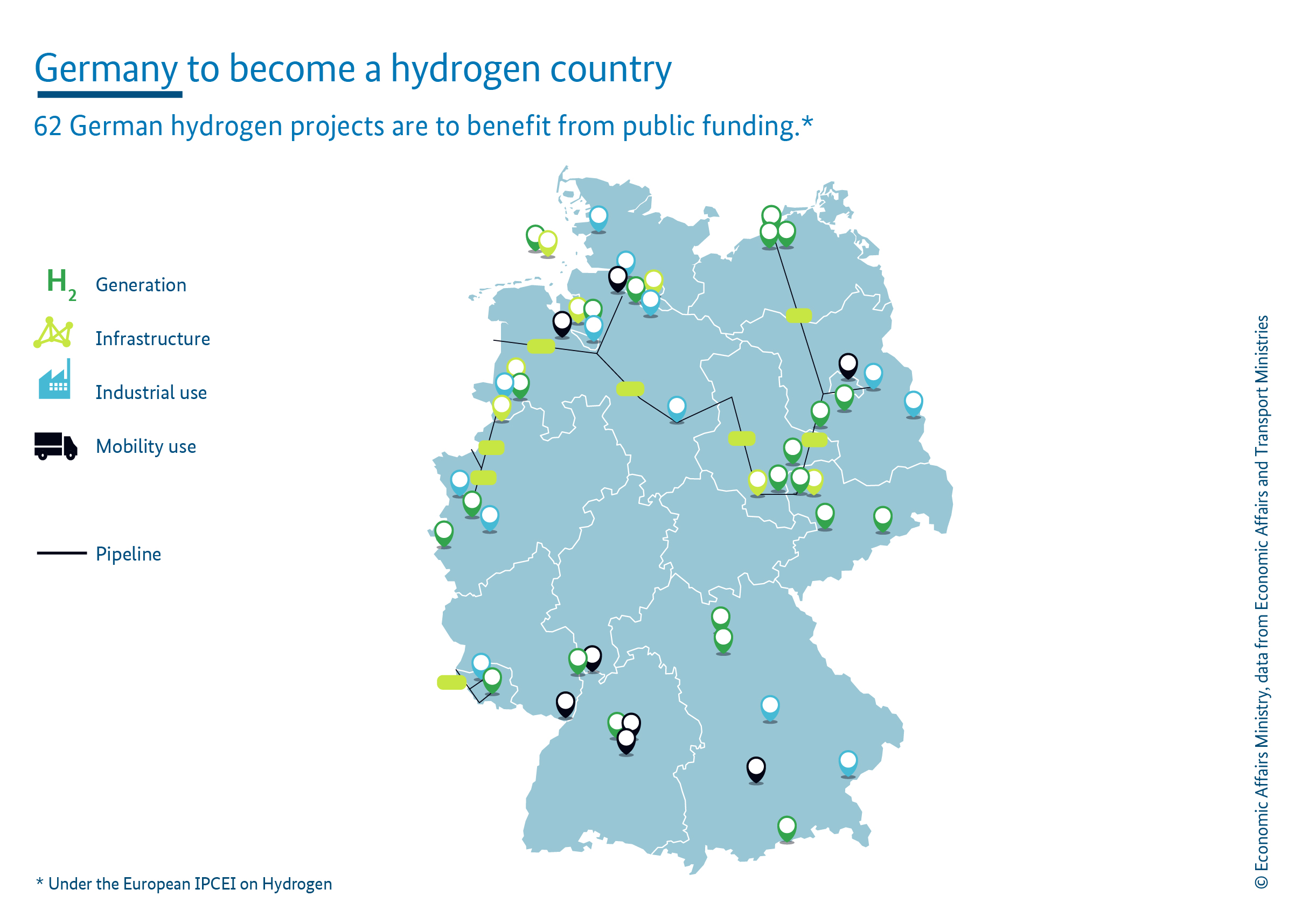Germany set to become a hydrogen country
62 large-scale hydrogen projects are to receive public funding under an Important Project of Common European Interest (IPCEI) for hydrogen. The measure forms part of the National Hydrogen Strategy.
 © Economic Affairs Ministry, data from Economic Affairs and Transport Ministries
© Economic Affairs Ministry, data from Economic Affairs and Transport Ministries
“Our goal is to become the global leader in hydrogen technology” – a sentence which has often passed Economic Affairs Minister Peter Altmaier’s lips and clearly points to the path that Germany has embarked on in its National Hydrogen Strategy.
A key measure in the Strategy is the funding of large-scale hydrogen projects in Germany. In mid-May 2021, the Economic Affairs Ministry and the Transport Ministry selected 62 large-scale hydrogen projects, which cover the entire hydrogen value chain, from a total of more than 230 submitted project outlines. The funding is to be provided within the framework of a European IPCEI for hydrogen – together with up to 22 European partner countries. The aim is to link the various national projects in a way that allows the participating countries to benefit from one another (“spill-over effects”) and set up a European hydrogen economy together.
Said Economic Affairs Minister Altmaier: “To this end, we are joining forces in Europe, stimulating massive investment in a forward-looking technology through the launch of the first common European project on hydrogen. This will safeguard our competitiveness and secure jobs – both in Germany and across Europe.”
€8 billion from federal and Länder funds
More than €8 billion in federal and Länder funds is available for the 62 selected projects. In total, the aim is to stimulate investments worth €33 billion, with over €20 billion to be provided by private investors. An important feature is the fact that the projects cover the entire hydrogen production value chain from transport to applications, particularly in industry and the field of mobility.
The selected project outlines include generating installations which together account for over 2 GW of electrolysis capacity for the production of green hydrogen. This corresponds to a share of more than 40% of the 5 GW target for 2030 set out in the National Hydrogen Strategy. The hydrogen that is produced will need to be transported, so the IPCEI will also help to create 1,700 km of hydrogen pipelines via the rededication of gas pipelines and the building of new pipelines.
“We are thus taking a major step on the path to a climate-neutral economy. Key areas to focus on include the steel sector and the chemical industries, where these hydrogen projects will make it possible to save several million tonnes of carbon every year”, Minister Altmaier stressed. All of the major steel producers operating in Germany have submitted investment projects. The 62 selected projects also include innovative chemical industry projects. Amongst other things, the zero-carbon production of hydrogen and its subsequent use could generate massive potential for reduction – e.g. for the manufacture of methanol or synthetic fuels for heavy goods vehicles or air traffic.
The Federal Ministry of Transport and Digital Infrastructure is funding twelve projects in the mobility sector which are centred not least on the development and production of fuel cell systems and vehicles. Support is also to go towards the establishment of a nationwide hydrogen refuelling infrastructure as part of a cross-border network.
The launch of the funding for the 62 large-scale hydrogen projects was announced by Economic Affairs Minister Altmaier in December 2020 under Germany’s Presidency of the Council of the European Union. The aim is to have approval under State aid rules from the European Commission for the first projects before the end of this year. A detailed overview of the projects and their distribution across Germany can be found on the IPCEI location map (PDF-Download, 253 KB).

